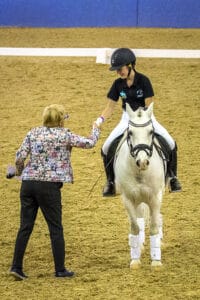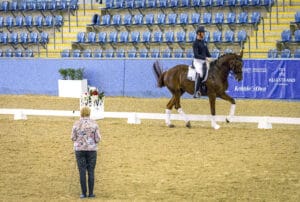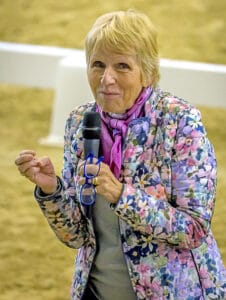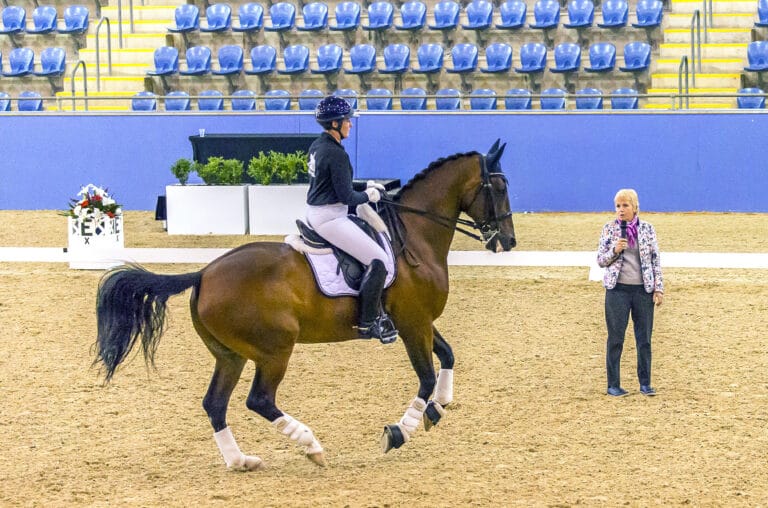With borders reopening and travel normalising, what a treat to have 5* dressage judge Katrina Wüst visit our shores again. REBECCA ASHTON reports.
Katrina Wüst is no stranger to Australia. Fresh from her role as president of the Tokyo Olympics ground jury, she judged at the Sydney CD-Lite, and gave a judges’ clinic after the event. Although literature and journalism have been an income mainstay over the years, judging the top sport is her passion and as a Grand Prix rider, she successfully guides riders into a better way of going. Katrina’s thoughtfulness and skill also shine when analysing freestyles, providing more creative and interesting lines to lift tests to another level.
Always thinking of new ways to improve the sport, Katrina not only introduced the degree of difficulty system for the Grand Prix Kur, but more recently developed and has been the driving force behind the FEI’s children’s tests.
Spectators were treated to 11 combinations over the day, each presenting a test, from young horse to Grand Prix. Afterwards Katrina guided each rider in ways to improve their marks, a bit like a protocol day. Seven riders demonstrated national and FEI dressage tests, Jessica Skinner on her pony Burrowa Bashar gave an example of the children’s tests, and three riders presented their freestyles.
Right through the levels, one of the most common themes was to first get the horse over the back. Katrina wanted them to open up their backs and stretch down to the bit with good bend in their ribs. Her aim was to dispel any muscle tightness before putting them up into collection. This resulted in more fluent, active, harmonious and better balanced horses right through the day.

Jessica Skinner and her pony Burrowa Bashar gave an example of the children’s tests
When helping Denise Rogan and her Prix St Georges horse Greco, Katrina encouraged her to: “Keep the frame open. Collect and sit a little more. And now forward on the circle. Come from the outside rein. Keep him on your seat. Collect with the outside rein. Very good.”
Danielle French on the six-year-old Hollands Bend Finders Keepers was another recipient of Katrina’s expertise: “In the bend, it isn’t about making the inside muscles short, it’s about making the outside muscles long. Now flex her to the outside and ride her up. Push her from your seat. More collection. It’s good but she can do more. Flex to the outside so you strengthen the inside hind leg.”
Another point surfacing during the lessons was for the riders to ride more from their seats, especially when the horses came behind the rider’s aids. “It’s important you do it with the seat and not the legs,” Katrina explained. “Don’t push so much with them. The horse will clamp on them. Use your legs for the half passes and passage. Think of Isabell and Edward Gal. Your seat is the connection to your horse’s back. You must develop the normal paces and activity from your seat.” This approach greatly improved the cadence.
Suppleness and flexion of the poll was also addressed right up to the top level. As Robert Schmerglatt guided Quando Queen through her first Grand Prix, Katrina advised him to: “Flex her to the inside and outside, but just between the ears. Don’t force her to be there with the hands, but address it if she doesn’t want to keep it herself. Insist on her being through and not being too high with the poll. Don’t let her nod. Collect a little more. Ride her without reins. Very good.” The German judge wanted the poll just to click over. The problem needed to be addressed but then the horse left alone and not held in place.
Tanisha Ryan was on the sweetest four-year-old Sevenoaks Fenrys, who she had broken in herself, and Kate Taylor-Wheat rode the five-year-old MS Fiontieni. Although both horses were young, Katrina encouraged their riders to ask for a little more carrying from the hind legs. This created better balance in the horses, their front ends were looser and they were less inclined to forge and run forward, sometimes away from the rider’s seat.
Katrina kept these periods short so as not to tire the youngsters. Kate was instructed not to push her mare: “Flex her to the outside. Ja. Better. She will get used to it. Do it from the outside. It is more important that she is round and over the back. Sit her from your seat. Don’t push her. You decide the tempo so she doesn’t rush. We actually need her less active at the moment so we can have her more supple and teach her to carry.”

Robert Schmerglatt guided Quando Queen through her first Grand Prix test.
Accuracy when riding tests was also emphasised more than once. “What is important for me when I judge Prix St Georges, the first medium trot isn’t extended trot. I give a good mark for a medium trot,” Katrina explained. “The legs can be a little rounder. The short side afterwards is part of the movement. You should wait until after the short side to give the mark. It’s 20 metres and nearly one third of the whole movement. The rider must be precise and not just rely on the quality of the horse. You don’t get three or four strides to prepare for the change, for example.”
Half pirouettes also had to be ridden accurately: “It must be on the line and not outside of the line and then the pirouette is a little big. If it’s on the other side of the centreline, I go down to 6.”
Katrina explained that movements like tempi changes must also be placed correctly and centred on the diagonals, and that every movement should be symmetrical in both directions. This requires not just accurate riding but an evenly trained, symmetric horse. Any one-sidedness in the horse should be addressed in their training.

A top judge, Grand Prix rider and innovator, Katrina Wüst’s passion for dressage is unmistakable
Katrina Wüst could easily be the queen of freestyle judging, and it was interesting to watch her work with three riders to change and improve the lines in their tests. She came up with some great combinations. It was also important to remember, she said, that “the harmony mark is the reigning mark of the freestyle.”
With the structure of the test, Katrina was keen to see an interesting beginning and end, like a good book. The use of the arena was also addressed, as was the importance of symmetry, balance, and not repeating the movement on the same side. The test also had to be balanced in terms of the amount of time spent in each pace and the ability to highlight good movements and cleverly mask weaknesses.
In Katrina’s opinion, the choice of music needs a lot of attention and is less subjective than you might think. It must match the paces and the transitions must match the music not the letters: “It should fit the rider and horse and should create emotions. Anky was very emotional with her French song. Isabell, Jessica all create very emotional freestyles.” Perhaps worth searching for clips of these three dressage greats, and listening as you watch.
Thank you Katrina for such a generous sharing of knowledge. It is a rare privilege to get help and insight from one of the world’s best. Also, a big thank you to all the riders. It’s never easy to put yourself out there for all to see, but without you we wouldn’t learn as much.
Feature image: Katrina offers advice to Denise Rogan on her Prix St Georges horse Greco.
All images by Rebecca Ashton.



